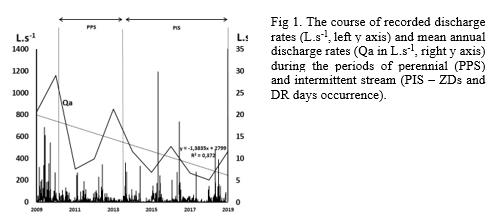THE RESPONSE OF MACROINVERTEBRATE ASSEMBLAGE ON LONG-TERM EXTREME FLOW RATE FLUCTUATIONS IN A CARP POND INFLOW CANAL
Introduction
Between 2014 and 2019, Central Europe was subject to unusually high temperatures and periods of drought due to climate change, with a subsequent negative impact on stream flow regimes, including the canals, providing water inflow to carp ponds . We examined changes in macrozoobenthos community composition and diversity in a small fishless brook (Němčický potok ) supplying water to 0.5 ha carp pond in highland during the last decade. As temperatures rise and rainfall declines, many small water courses are likely to shift from permanent streams to intermittent (riffle-pool sequences replaced by isolated pools) or ephemeral (periods characterised by regular occurrence of dry riverbed ) streams during periods of drought, often for periods of several weeks or longer (Bonada et al. 2006).
Material and Methods
While flow rates were relatively constant prior to 2014, the hydrological regime was significantly influenced by periods of severe drought between 2017 and 2019, with periods of zero discharge (ZD) and dry riverbed (DR) days . As this time period was characterized by dramatic decline of flow rates and by onset of atypical events of flow cessation and dry riverbed, the community of benthic macroinvertebrates (MIV) passed significant changes.
Benthic MIV samples were obtained semi-quantitatively using a 1-minute hand-disturbance and sweep approach using a 0.5 mm mesh hand net (200x100 mm aperture). After laboratory processing, each taxon was assigned to one of four groups based on hydrological preferences, i.e. lotic, generalist, lentic or semi-aquatic. The classification by Sládeček [16], expressed as a saprobic index (SI) was applied for assigning taxa into appropriate water quality (saprobity ) categories in accordance with Czech National Standard [38], i.e . good , moderately polluted , polluted and heavily polluted.
Results
Hydrological patterns
We recorded no ZDs during the period between 2010 and 2011, with the first events being recorded in 2012 and 2013, though still with no DR occurrence - this was considered as a period of a perennial stream (PPS). The first eleven DR days occurred in 2014, persisting throughout the whole period until 2019. The highest DR frequency was recorded in 2015, with 110 ZDs and 81 DRs, and 2017, with 108 ZDs and 57 DR days which represented a period of an intermittent stream (PIS).
The average annual discharge rates (Qa) ranged between 7.57 to 28.96 L.s-1 during the period 2010–2013, and 5.06 to 12.78 L.s-1 during the period 2014–2019 (Fig. 1). Overall, Qa showed a declining trend (R2 = 0.372, p = 0.046) between 2010 and 2018 with Qa dropping from 28.96 L.s-1 to 5.06 L.s-1 (Fig. 1).
The response of benthic MIV in the NEM brook was clearly dependent on the flow regime, and particularly on the frequency and duration of the ZD period. Taxa associated with lotic-habitats (e.g. Gammarus fossarum , Baetis vernus and Micropsectra sp.) dominated during the PPS period without ZDs (Fig. 2). During the dryer PIS period, however, lotic-habitat indicators had dropped, while the number of generalist taxa increased.
Conclusion
The macroinvertebrate community structure in a small fishless pond inflow canal was shaped by a transition from permanent to intermittent discharges resulting in waterless periods. The clearest impacts of this transition were a dramatic reduction (almost disappearance) in the population of G. fossarum and the prevalence of oligochaetes and dipteran larvae. Overall, the structure of the benthic macroinvertebrate assemblage shifted from being dominated by lotic taxa and good water quality indicators to one dominated by generalists and more tolerant taxa associated with more polluted environments.
Acknowledgement
This research and the article were funded by the Ministry of Agriculture CR in the frame of the project QK1910282 and the Institutional support MZE-RO0218.
References
Bonada , N.; Rieradevall , M.; Prat, N.: Benthic macroinvertebrate assemblages and macrohabitat connectivity in Mediterranean-climate streams of northern California. J N Am Benthol Soc 2006 , 25, 32-43.
ČSN 75221. Water quality – Classification of surface water quality. ČNI Prague, 2017, 10 p.
Sládeček, V. System of Water Quality from the Biological Point of View . Adv Limnol 1973 , 7, 1-218.

